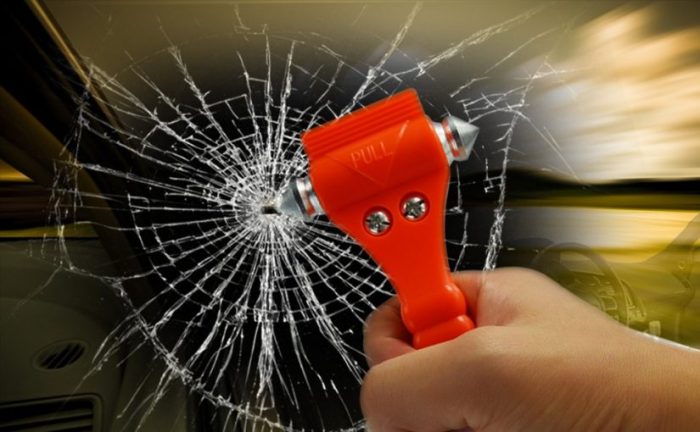Best emergency escape tools for cars? Dude, that’s a seriously important topic. We’re not talking about just any old car accessory; we’re talking about potentially life-saving gear. This guide breaks down the best window breakers, seatbelt cutters, escape ladders, and more, helping you choose the right tools for your ride and prepping you for any unexpected situation.
We’ll cover everything from how to use these tools to choosing the right ones for your car and even some alternative escape methods if things get really hairy.
Knowing how to get out of a car quickly in an emergency is crucial. Whether it’s a fiery wreck or a submerged vehicle, having the right tools and knowing how to use them could be the difference between life and death. We’ll explore different types of escape tools, their pros and cons, and what to look for when buying.
Plus, we’ll cover some crucial safety tips and emergency procedures to help you stay calm and think clearly under pressure.
Types of Emergency Escape Tools

Getting out of a car quickly in an emergency is crucial, and having the right tools can be a lifesaver. This section explores the various types of emergency escape tools available, their construction, effectiveness, and ease of use. Understanding these tools can significantly improve your chances of a safe escape in a crisis.
Emergency escape tools are designed to help you overcome obstacles that might prevent you from quickly exiting a vehicle after a collision or other emergency. These obstacles often include jammed doors, shattered windows, and entangled seatbelts.
Emergency Escape Tool Categories
Several categories of emergency escape tools address specific challenges in escaping a vehicle. These tools are designed to work together or independently, depending on the nature of the emergency.
The most common categories include window breakers, seatbelt cutters, and escape ladders or hammers. These tools are often combined into a single unit for convenience and efficiency.
Materials Used in Emergency Escape Tools
The materials used in constructing emergency escape tools directly impact their durability, effectiveness, and overall lifespan.
Window breakers often utilize hardened steel or tungsten carbide tips for maximum impact strength. These materials are chosen for their ability to shatter toughened automotive glass efficiently. Seatbelt cutters typically employ high-carbon steel blades, renowned for their sharpness and ability to cut through seatbelts quickly and cleanly. The handles of these tools are often made of durable plastics or reinforced polymers to withstand impacts and provide a secure grip.
Less durable materials might be susceptible to damage or breakage during use, compromising their effectiveness. For example, a poorly constructed window breaker might bend or break under pressure, rendering it useless in a critical situation. Similarly, a dull or weak seatbelt cutter blade could fail to sever a seatbelt quickly enough, delaying escape.
Manual Versus Automated Escape Tools
The choice between manual and automated escape tools often comes down to personal preference and the specific needs of the user.
Manual tools, such as handheld window breakers and seatbelt cutters, require direct physical action to operate. This provides a degree of control and ensures that the tool is only used when needed. However, they may be less effective in situations where speed and dexterity are compromised due to injury or panic. Automated tools, on the other hand, often deploy with a single action (like pressing a button) but might be more prone to malfunction or accidental deployment.
Comparison of Emergency Escape Tools
The following table compares five common emergency escape tools, considering price, features, and ease of use. Remember that prices can vary depending on the brand and retailer.
| Tool | Price Range | Features | Ease of Use |
|---|---|---|---|
| Handheld Window Breaker & Seatbelt Cutter Combo | $10-$30 | Integrated window breaker and seatbelt cutter, often includes a flashlight | Easy; simple to operate under pressure |
| Emergency Hammer with Seatbelt Cutter | $15-$40 | Heavy-duty hammer for breaking windows, integrated seatbelt cutter, sometimes includes a sharp point for puncturing tires | Moderately easy; requires more force than a combo tool |
| Vehicle Escape Tool with LED Light | $20-$50 | Window breaker, seatbelt cutter, and built-in LED light for visibility in dark conditions | Easy; often has a more ergonomic design |
| Small, Keychain-Sized Window Breaker | $5-$15 | Compact and portable, ideal for carrying in a purse or pocket; only a window breaker | Easy; small size might require more precise aiming |
| Multi-tool with Window Breaker and Seatbelt Cutter | $25-$60 | Combines multiple functions (e.g., knife, screwdriver, pliers) with a window breaker and seatbelt cutter | Ease of use varies depending on the specific tool; more complex than dedicated escape tools |
Factors to Consider When Choosing Escape Tools

Choosing the right emergency escape tool for your car isn’t just about picking something that looks cool; it’s about making sure you have the best chance of getting out safely in a truly awful situation. Different tools have different strengths and weaknesses, and the best choice depends heavily on your specific needs and the types of emergencies you might face.
Let’s dive into the factors you should keep in mind.
Vehicle Type and Escape Tool Compatibility, Best emergency escape tools for cars
The type of vehicle you drive significantly impacts the escape tool you should choose. A compact car might require a different solution than a large SUV or a truck. For example, a window breaker might be sufficient for a smaller car, but a larger vehicle might benefit from a combination tool including a seatbelt cutter and a more powerful window punch.
Consider factors like window thickness and the location of escape routes within your specific vehicle model. A tool designed for smaller windows might not be powerful enough to break the thicker, laminated glass often found in larger vehicles or SUVs.
Limitations of Escape Tools in Different Emergency Scenarios
Different escape tools have varying effectiveness in different emergency situations. For instance, a simple window breaker might be great for a minor accident, but it may not be sufficient if your car is submerged in water. In a submerged vehicle scenario, a specialized tool designed to cut through seatbelts quickly becomes crucial, as does a tool that allows for rapid window egress.
Similarly, a fire scenario necessitates a tool that can withstand high temperatures and cut through seatbelts even when they are melted or damaged by heat. The effectiveness of different escape tools is highly scenario-dependent, requiring careful consideration of potential emergency situations.
Safety Features and Certifications
When buying an escape tool, don’t just grab the cheapest one. Look for tools with safety features that minimize the risk of accidental injury. A good window breaker, for instance, should have a blunt tip or a protective cover to prevent accidental cuts or punctures. Check for certifications from reputable organizations that indicate the tool has undergone rigorous testing to meet specific safety standards.
So, you’re prepping your emergency car kit – gotta have that window breaker and seatbelt cutter, right? But, life happens, and sometimes getting a new car after, say, a financial hiccup is necessary. If you’re facing challenges like bankruptcy, checking out resources on Bankruptcy and car loan approval 2025 might be helpful before you even think about what kind of escape tool to buy for your next ride.
Anyway, back to that escape kit – a good flashlight is also a must-have.
These certifications ensure the tool’s reliability and effectiveness in emergency situations. Look for markings indicating compliance with relevant safety standards and regulations.
Prioritized Factors When Choosing an Emergency Escape Tool
Choosing the right emergency escape tool requires careful consideration of several factors. It’s a matter of safety and preparedness, so it’s worth spending some time thinking it through.
- Ease of Use: In a panic situation, you need a tool that’s intuitive and easy to operate, even under stress.
- Durability and Reliability: The tool needs to withstand the rigors of an emergency situation and perform consistently.
- Versatility: A combination tool offering both seatbelt cutting and window breaking capabilities is often the most practical choice.
- Safety Features: Prioritize tools with features designed to prevent accidental injuries during use.
- Certifications and Standards: Look for tools that meet or exceed relevant safety standards and have undergone rigorous testing.
- Vehicle Compatibility: Consider your specific vehicle type and window thickness when selecting a tool.
Proper Use and Maintenance of Emergency Escape Tools: Best Emergency Escape Tools For Cars
Knowing how to properly use and maintain your car’s emergency escape tools could be a lifesaver. These tools, often overlooked, can mean the difference between a stressful situation and a safe escape. This section will cover the effective use of common escape tools, the importance of regular checks, and safe storage practices.
Using a Window Breaker and Seatbelt Cutter
Effective use of a window breaker and seatbelt cutter requires both understanding and practice. These tools are designed to be used in high-stress situations, so familiarity is key. First, locate the tool. Many are integrated into the car’s design, often near the driver’s seat or in the glove compartment. Familiarize yourself with its placement
before* an emergency arises.
So, you’re prepping your ride with emergency escape tools – that’s awesome! But while you’re at it, don’t forget to protect your car’s interior. Snag some sweet protection with these Affordable steering wheel covers for leather protection to keep your steering wheel looking fresh. Then, get back to stocking up on those essential escape tools for peace of mind on the road!
- Seatbelt Cutter: To release a stuck seatbelt, firmly press the cutting edge of the tool against the seatbelt strap, near the buckle. Apply firm, even pressure while simultaneously moving the tool along the strap to sever it. Avoid cutting yourself or others.
- Window Breaker: Identify the vehicle’s window you want to break. Aim for a corner of the window, as this is the weakest point. Hold the window breaker firmly and strike the corner with a swift, decisive blow. Multiple strikes may be necessary depending on the window’s thickness and the tool’s strength. After breaking the window, clear away any remaining shards before exiting.
Practice using these tools in a safe environment, like your driveway or a well-lit garage, to build confidence and familiarity with their operation.
Regular Inspection and Maintenance
Regular inspection is crucial for ensuring your emergency escape tools remain functional. Think of it like checking your smoke detectors; it’s a preventative measure.
- Check the blade of the seatbelt cutter for any signs of damage, dullness, or rust. A dull blade may not cut through the seatbelt effectively.
- Inspect the window breaker for cracks or damage to the striking tip. A damaged tip could reduce its effectiveness or even cause it to break during use.
- Test the functionality of both tools periodically, using scrap materials to simulate a seatbelt and glass. This will help you understand how much force is required and identify potential issues early.
Replace any damaged or malfunctioning tools immediately. The cost of replacement is far less than the potential cost of an ineffective tool during an emergency.
Safe and Accessible Storage
Storing your escape tools appropriately ensures they’re readily available when needed. Avoid storing them in locations that are difficult to access during an emergency, such as the trunk or under the seats.
Ideally, keep them within easy reach of the driver and passengers. The glove compartment, a door pocket, or a dedicated holder near the seat are all good options. Ensure the storage location is clearly visible and easily accessible, even in low-light conditions. Consider using a brightly colored case or container to improve visibility.
Deploying an Emergency Escape Ladder
Emergency escape ladders are designed for use in situations where exiting the vehicle through the doors is impossible. Before needing it, understand how your specific ladder works. They usually deploy by pulling a release cord or latch.
Once deployed, carefully lower the ladder to the ground. Ensure the ladder is securely positioned and stable before using it. Then, carefully descend the ladder, maintaining three points of contact (two hands and one foot, or two feet and one hand) at all times. Avoid rushing and maintain a steady pace.
Alternative Escape Methods
Sometimes, you might find yourself in a car accident where specialized escape tools aren’t readily available, or the situation demands a quicker, more immediate escape. Knowing alternative methods can be crucial in these scenarios. These methods prioritize safety and rely on your quick thinking and physical ability.Understanding how to escape from a vehicle without specialized tools depends heavily on the type of vehicle and the specific circumstances of the accident.
Factors like the severity of the impact, the location of the damage, and the presence of fire or other hazards all play a significant role in determining the safest and most effective escape route. Always prioritize your safety and act decisively.
Escape Methods Based on Vehicle Type
Different vehicle types present unique challenges and opportunities for escape. Sedans typically offer easier access to doors, while SUVs might have higher ground clearance, potentially making it easier to climb out of a broken window. Trucks, depending on their size and configuration, might require different strategies. In each case, the most important thing is to assess the situation quickly and choose the path of least resistance while avoiding known hazards.
For example, if a door is jammed, attempting to force it open might be dangerous if there’s a risk of further injury or the vehicle is unstable. Choosing an alternative escape route, such as a window, might be the safer option.
Actions Before, During, and After a Car Accident
Before an accident, ensuring all passengers are wearing seatbelts is paramount. This is a crucial step to minimize injuries and improve the chances of a safe escape. During an accident, assess the situation quickly. Check for injuries to yourself and your passengers. If it’s safe to do so, turn on your hazard lights.
If possible, move your vehicle to a safe location away from immediate danger. When exiting, always check for oncoming traffic. After the accident, contact emergency services immediately. If you are able, gather information such as location, license plate numbers, and witness details.
- Before: Seatbelts fastened, awareness of surroundings.
- During: Assess situation, activate hazard lights, check for injuries, if safe, move to safer location.
- After: Contact emergency services, gather information.
Circumstances Favoring Alternative Escape Methods
Alternative escape methods are preferable when specialized tools are unavailable, such as in remote areas or when immediate action is necessary due to fire or other imminent threats. For example, if a vehicle is engulfed in flames, attempting to use a window breaker might be too time-consuming; escaping through a broken window or an undamaged door might be more effective.
Similarly, if a door is completely jammed or inaccessible due to severe damage, an alternative escape route such as a window is necessary. The primary goal is always to get yourself and your passengers to safety as quickly and safely as possible. The choice of escape method should always be guided by a rapid assessment of the immediate risks and the available options.
Illustrative Examples of Emergency Situations
Emergency escape tools are crucial for survival in unexpected vehicle incidents. Understanding their application in diverse scenarios is key to effective use and maximizing your chances of safe egress. The following examples highlight the importance of selecting and using the right tools for specific situations.
Scenario 1: Submerged Vehicle
Imagine a late-night rainstorm. You’re driving a compact sedan, a Honda Civic, when you hydroplane and plunge into a shallow, fast-flowing creek. The car’s windows are fully up, and the doors are jammed shut due to the water pressure. The environment is dark, cold, and the current is strong. The immediate challenge is escaping the rising water before you become trapped or incapacitated.The most appropriate escape tool here is a spring-loaded center punch or a window breaker.
These tools are designed to shatter tempered glass quickly and efficiently, even under pressure. Using a seatbelt cutter to sever the seatbelt and then a window breaker to create an escape route is the most effective method. Attempting to open the doors would be futile due to the water pressure, and delaying escape attempts drastically reduces survival chances.
Failing to use an appropriate tool, such as relying on a flimsy object like a tire iron, could lead to injury from the broken glass or insufficient force to break the window, resulting in drowning or severe hypothermia.
Scenario 2: Rollover Accident
A family is traveling in a large SUV, a Ford Explorer, on a winding mountain road. The vehicle loses control on a sharp turn, rolls over several times, and comes to rest on its side. The impact has caused significant damage, and some doors are jammed or impossible to open. The environment is rural, with limited immediate access to emergency services.
The challenges are escaping the vehicle quickly and avoiding further injury from the unstable vehicle position.In this scenario, a combination of a seatbelt cutter and a window breaker is again ideal. The seatbelt cutter quickly frees the occupants from their restraints, allowing them to move more freely. The window breaker then creates an escape route from the upside-down vehicle.
Using only a window breaker without first freeing the seatbelts would severely hinder escape and potentially trap occupants. Relying on alternative methods, like trying to pry open a jammed door with limited tools, would consume precious time and could lead to further injury from the vehicle’s unstable condition or from the sharp edges of the vehicle’s interior.
Scenario 3: Post-Collision Entrapment
A collision occurs between a small pickup truck and a semi-trailer truck on a busy highway. The pickup truck is severely damaged on the driver’s side, with the door jammed shut by the impact. The environment is a high-traffic area, with the risk of further accidents. The immediate challenge is escaping the vehicle before additional vehicles collide with the wreckage or a fire breaks out.In this instance, a combination tool featuring both a seatbelt cutter and a window breaker is again the most effective solution.
Quickly cutting the seatbelt and breaking a window on the passenger side provides a clear escape path. Trying to force the jammed driver’s side door open would waste precious time and potentially worsen the injuries. Using only a single tool – for instance, only a hammer to try to break the window – could cause injuries from the shattered glass and would be significantly slower than a specialized tool designed for this purpose.
The consequences of delayed escape in this high-traffic scenario could be catastrophic, leading to further injury from another collision or entrapment in a fire.
Concluding Remarks
So, there you have it – a crash course (pun intended!) on emergency escape tools for your car. Remember, being prepared is key. Having the right tools and knowing how to use them can significantly improve your chances of escaping a dangerous situation. Don’t just throw a random tool in your glove compartment; take the time to choose the right gear for your needs and practice using it.
Your life might depend on it. Stay safe out there!









